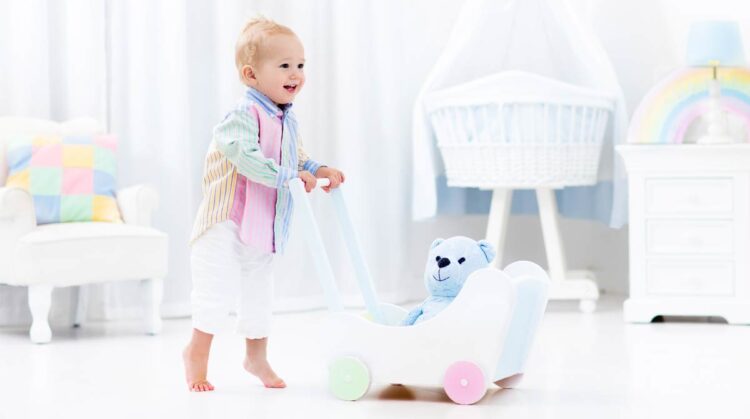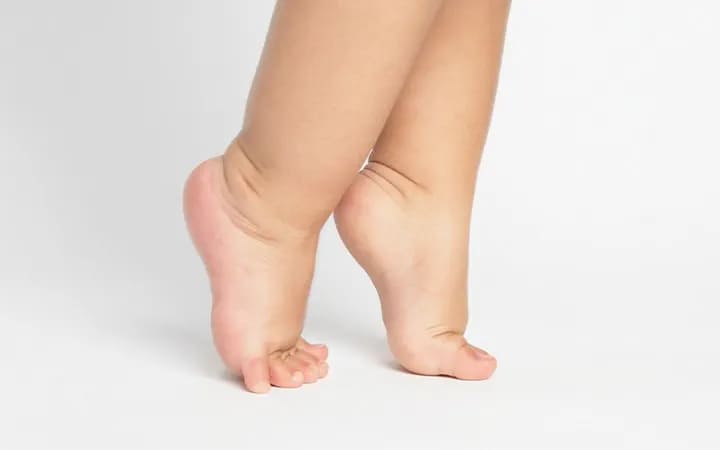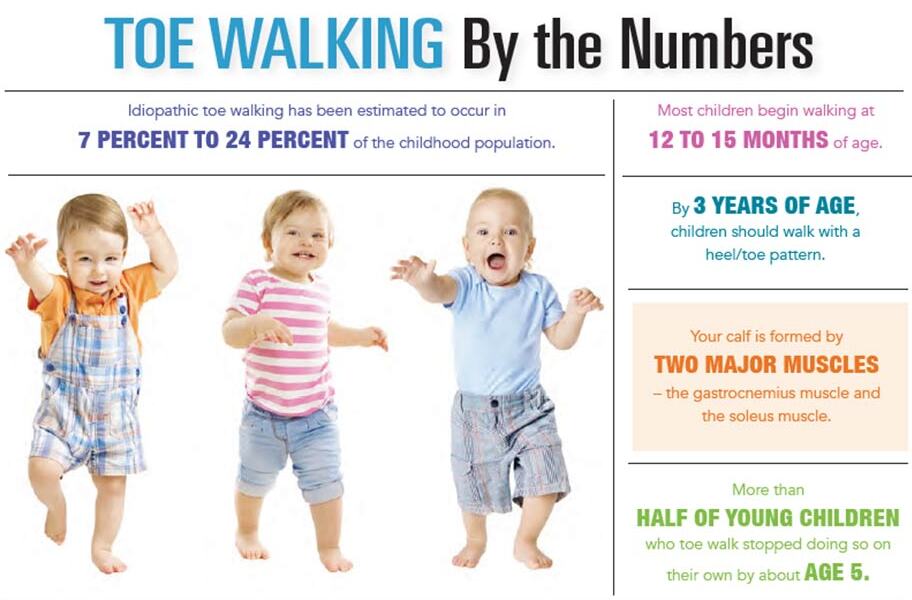टो वॉक म्हणजे काय?
Toe walking is when a child walks on the tips of their toes instead of putting their heels down first. It may look like little feet dancing or sneaking around, but it’s just their way of moving.
टो वॉक म्हणजे जेव्हा बाळ किंवा लहान मूल आपल्या पुढच्या पायाच्या बॉल्स किंवा टाच्याच्या पुढच्या भागावर चालते, टाच जमिनीला लावत नाही. हे काहीसं नाचायला, गुप्तपणे चालायला वाटतं, पण फक्त त्यांचा चालण्याचा वेगळा प्रकार आहे.
Key points – What toe walking looks like:
- Child’s heels do not touch the ground when they walk
- They stand and move on the balls of their feet or toes
- Sometimes they run or stand this way, too
Many toddlers try this out between ages 2–3. It can be a phase of play or a curious experiment with balance.
टो वॉक दिसण्याची लक्षणे:
- चालताना टाच जमिनीला स्पर्श करत नाही
- पायाच्या पुढच्या भागावर किंवा पंजांवरून चालणे
- कधी कधी धावताना किंवा उभे राहताना पण अशाच प्रकारे चालणे
अधिकांश बाळं २–३ वर्षांच्या दरम्यान हे प्रयोग करत आहेत.
Why Do Kids Toe Walk?
Most of the time, toe walking is harmless and temporary. Here are a few simple reasons why children might do it:
- Fun and Experimentation
Toddlers love trying new things. Walking on toes feels different—like being on a tightrope.
- Muscle Tightness
If the calf muscles or Achilles tendon are a bit tight, it can feel easier to tip‑toe.
- Sensory Preference
Some kids like the extra stretch or the “bouncy” feeling under their feet.
- Developmental Links
In a small number of cases, toe walking can be linked to other conditions (for example, mild cerebral palsy or autism). But this is less common.
लहान मुलं टो वॉक का करतात?
टो वॉक बहुधा निरोपदायी आणि तात्पुरत्या स्वरूपाचं असतं. काही सामान्य कारणं:
- खेळ आणि प्रयोग
बाळं नवीन गोष्टी करण्यास आवडतात. टो वॉक यामुळे संतुलनाची मजा घेता येते—जसं अंगणात उंचावरून चालणं.
- स्नायूंचं तणाव
पायाची पिडक स्नायू किंवा अचिलीस सेतू (Achilles tendon) घट्ट असतील, तर टाच जमिनीला लावल्यावर अडचण जाणवत असते.
- संवेदी आवड
काही मुलांना या चपळ हालचालीमुळे मिळणारी “बाऊन्स” किंवा ताण आवडतो.
- विकासाशी निगडीत मुद्दे
काही प्रमाणात टो वॉक लोकल पातळीवरील विकासातील अडथळ्यांशी (उदा. सौम्य सेरेब्रल पाल्सी, ऑटिझम) संबंधित असू शकतो—परंतु हे क्वचितच असतं.
When to Worry and Meet the Doctor
Most children grow out of toe walking by age 3 or 4. However, you should arrange a check‑up if you see any of these signs:
- Toe walking continues past age 4
- Only one foot is always on tip‑toes
- Your child complains of pain in calves or heels
- Walking looks uneven or they limp
- Other delays in speech, social skills, or motor skills
If any of these sound familiar, call your pediatrician. A quick exam can measure ankle flexibility, check muscle tone, and make sure everything is on track.
कधी चिंता करावी आणि डॉक्टरांकडे कधी जायचे?
अधिकांश मुले ३–४ वर्षांच्या आत टो वॉक थांबवतात. मात्र खालील लक्षणे असल्यास डॉक्टरांचा सल्ला घ्या:
- ४ वर्षांनंतरही टो वॉक सुरु आहे
- फक्त एका पायावर नेहमी टो वॉक करणे
- पायात किंवा टाचीत दुखतं असं बाळ म्हणणं
- चालताना असमान किंवा लँपिंग (लंगडा चालणे) जाणवणे
- भाषा, सामाजिक किंवा मोटर कौशल्यांमध्ये उशीर
या पैकी एखादी गोष्ट दिसल्यास आपल्या बालरोगतज्ञाला भेट द्या. सर्वसाधारण तपासणीत टाच आणि पायाचा लवचीकपणा मोजला जातो आणि इतर स्नायूंची स्थिती तपासली जाते.
Simple Tips to Help
Even before you see the doctor, you can try some gentle steps at home:
- Stretch Daily
- After bath time, gently stretch your child’s calf by flexing the foot up toward the shin.
- Hold each stretch for 10–15 seconds, repeat 3–5 times.
- Play Heel‑First Games
- Lay tape or soft blocks in a line and ask them to step “heel on the tape.”
- Make it a fun challenge rather than a chore.
- Choose Supportive Shoes
- Look for shoes with a firm back (heel counter) to encourage heel‑down walking.
- Avoid flat‑soled sandals or flip‑flops for daily wear.
- Keep It Short and Sweet
- A couple of minutes of stretching or a quick game is plenty—short bursts work best for little attention spans.
घरच्या घरी साधी मदत कशी करावी?
डॉक्टरांच्या भेटीपूर्वी किंवा त्यानंतरही आपण हे प्रयोग करू शकता:
- दररोज स्ट्रेच करा
- आंघोळी नंतर, मुलाचं पाय तोंडाकडे वाकवून स्नायू हळूच ताणावा.
- प्रत्येक स्ट्रेच १०–१५ सेकंद ठेवा, ३–५ वेळा पुन्हा करा.
- हील‑फर्स्ट खेळ
- जमिनीवर टेप लावा किंवा मऊ उंचीचे ब्लॉक्स ठेवा.
- मुलाला “पहिले टाच टेपवर” असं खेळवत घरीवा.
- समर्थन देणारे बूट
- घट्ट पाठीचा भाग (heel counter) असलेले शूज वापरा, ज्यामुळे टाच जमिनीला आलं तर चालायला सोपं होईल.
- रोजच्या वापरासाठी फ्लॅट‑सँडल्स किंवा_flip‑flops टाळा.
- थोडावेळ, परंतु सतत
- दोन मिनिटं स्ट्रेचिंग किंवा एक लहान खेळ पुरेसा असतो—लहान लक्षवेधी मुलांसाठी छोट्या सत्रात काम होतं.
You’re Not Alone
Toe walking can be a bit confusing, but most kids tip‑toe through it and then land back on their heels. With simple stretches, playful exercises, and guidance from your pediatrician when needed, you’ll help your child find solid footing in no time.
तुम्ही एकटे नाहीत
टो वॉक बरेचदा फक्त लहान वयातील तात्पुरता व्यवहार असतो. साध्या स्ट्रेचिंग, खेळातून केलेले व्यायाम आणि आवश्यकतेनुसार बालरोगतज्ञाचा सल्ला घेऊन, आपण आपल्या बाळाला लवकरच टाच जमिनीवरून सुरक्षितपणे चालायला शिकवू शकता. आणि हो—कधी कधी हा “गुप्त निंजा” मूड त्यांचा खासपणाच दाखवतो! 😉
Disclaimer:
- The information provided in this blog post is for general knowledge and informational purposes only.
- It is not intended as a substitute for professional medical advice, diagnosis, or treatment.
- Always consult with a qualified healthcare provider for any health concerns or before making any decisions regarding your health or the health of your child.
- The information in this blog post may change as new research and clinical experience accumulate.
काळजीपूर्वक लक्षात घ्या:
- या ब्लॉग पोस्टमधील माहिती सामान्य ज्ञान आणि माहितीच्या उद्देशाने आहे.
- हे व्यावसायिक वैद्यकीय सल्ला, निदान किंवा उपचारांचे पर्याय म्हणून मानले जात नाही.
- आपल्या आरोग्याशी किंवा आपल्या मुलाच्या आरोग्याशी संबंधित कोणत्याही आरोग्य समस्यांसाठी किंवा कोणतेही निर्णय घेण्यापूर्वी नेहमी योग्य वैद्यकीय सेवा प्रदात्यांचा सल्ला घ्या.
- नवीन संशोधन आणि क्लिनिकल अनुभव जमा होतात तसे या ब्लॉग पोस्टमधील माहिती बदलू शकते.




Leave a comment